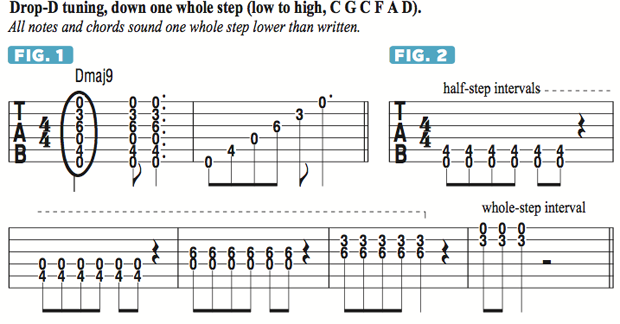Holcomb-Mania with Mark Holcomb: Using Dissonant, Close Intervals to Create Jarring Chords — Video

In last month’s column, I discussed some of the ways I will often expand on single-note riff ideas by substituting full-voiced chords for individual notes.
By applying this technique, I discovered a whole new approach to riff writing, and it has informed the music I create for my bands Periphery and Haunted Shores. This month, I’d like to continue with that topic and talk about my approach to using dissonant intervals in chords and as double-stops (two-note chords).
If you are familiar with Periphery’s music, you know that we love the sound of dense, atonal, dissonant chords. Personally, I love the tension created by stacking dissonant tones against each other in the formation of unusual and unexpected chords.
Oftentimes, these chords are formed by placing notes that are a half or whole step apart (or a major seventh, or minor or major ninth). The sound of these notes clashing against each other is a desired quality, if done right on our part.
There’s a chord in “Omega” (Juggernaut: Omega) that I’m often asked about. FIGURE 1 illustrates the chord in question, which can be analyzed as a very innocuous sounding Dmaj9(no3), voiced, low to high, D C# D C# D E. (As a reminder, my guitar is tuned to drop D down a whole step, but everything is thought of and notated as if it were in regular drop D, with the understanding that everything is going to sound a whole step lower.)
As shown in FIGURE 2, there is a major seventh interval between the sixth and fifth strings (this can be thought of as “half steps apart” because the pitches are D and C#), a half step between the fifth and fourth strings, a major seventh between the fourth and third strings, another half step between the third and second strings, and then a whole step between the second and first strings, which results in a very dense-sounding chord. It might, in fact, be the ugliest chord one can imagine! But we applied it in a place where what we wanted was a disastrous sounding chord.
FIGURE 3 illustrates a section of “Omega”—sort of the second half of the verse section—and I begin with the chord in question, striking it first and then sounding a repeated upbeat syncopation on palm-muted open sixth-string root notes.
All the latest guitar news, interviews, lessons, reviews, deals and more, direct to your inbox!
The chord is struck again in bar 2, after which an atonal ascending line is played which is based on no particular scale at all. It is a “random” sounding collection of notes that serves to set up the following chord, Dm6/9+5; this chord could also be analyzed in a few different ways due to its very dissonant quality.
I follow in bars 4 and 5 with sliding octave figures fretted on the sixth and fourth strings; when in drop-D tuning, the octave shape is formed by fretting notes at the same frets of these two strings. Bar 6 begins with a twist on the opening chord as the majority of the pitches are simply moved up one fret, resulting in D(f)9no3, “resolved” in bar 7 to D7#11, which is another chord that could be reckoned a few different ways.
The figure ends with syncopated strumming of upbeat accents and a return to the opening chord.
Next month, I will move on to more of the very unusual chords we devised in the writing of “Omega.” See you then.


